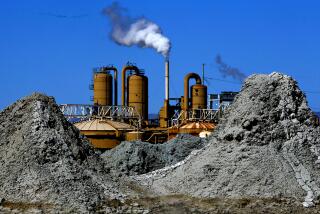Manufacturing Make-Over Reshapes Region
Despite wrenching cuts by major employers earlier this decade, the San Fernando Valley is still a manufacturing hub. You just might have a little trouble telling so by driving around.
Capacitors, bread and beer have replaced airplanes and autos as the region’s manufacturing mainstays. But some experts say the new look has helped buffer the Valley from the most recent round of manufacturing cutbacks, particularly in aerospace.
And beyond that, they say, the Valley, with its clutch of small- to mid-range manufacturers, is better poised today to respond to the rapidly evolving economy.
“In the ‘50s, the automotive companies and the aerospace companies were our core competency,” said David Goodreau, a Burbank-based manufacturer who for six years has headed up the Small Manufacturers Assn. of California. “They defined what it was to be in manufacturing in the San Fernando Valley. Today, it’s really defined by small family-owned firms that utilize their size and expertise to compete.”
Clearly, the Valley is still smarting from lost production jobs at places like Hughes Aircraft and General Motors. In the 1960s, Burbank’s Lockheed operation was the largest single employer in the Valley. When the operation moved to Georgia in 1990, it meant the loss of 8,000 Valley jobs.
Today, the region’s manufacturing community is on the mend, fueled not by behemoths with household names but by a diverse group of pocket-size plants, offering a diverse range of products. The metamorphosis appears to be helping the Valley weather yet another round of defense cutbacks in the county.
“What you’re seeing overall in Los Angeles County is that manufacturing is in job-loss mode,” said Jack Kyser, chief economist at the Los Angeles Economic Development Corp. But the Valley “might be holding its own a little bit better than the [rest of the] county,” he added.
The county’s manufacturing sector is estimated to lose more than 8,000 jobs this year, largely in the southeast section of the county and chiefly because of further cutbacks in aerospace.
“You’d probably be somewhat immune to that,” Kyser said, noting that we took our hit already.
From 1997 to ‘98, the county actually gained 6,700 manufacturing jobs, an increase of less than 1%. More than 1,000 of those jobs were in the Valley, where manufacturing jobs grew by just over 1%, according to a recent report from the San Fernando Valley Economic Research Center at Cal State Northridge.
During that same period, manufacturing was one of four employment categories to see an increase in the number of Valley jobs. While the numbers of retailing and service jobs (the two dominant Valley segments) were shrinking, manufacturing rose by a modest 1.09%.
While small, the jobs gain indicates that manufacturing remains a quiet force in the Valley’s economy, still offering some of the best-paying jobs around.
Without question the service sector dominates Valley employment, accounting for 45% of the 630,000 private sector jobs from Glendale to Calabasas.
By comparison, manufacturing accounts for about 97,500 jobs, or 15% of the Valley’s private sector total, according to figures from CSUN’s research center.
The average annual pay for workers in technology-based manufacturing in 1998 was $43,483, according to the CSUN study. It was the third-highest-paying field in the Valley, behind finance/insurance/real estate and mining.
For general manufacturing, which includes well-known names like Rocketdyne and Anheuser Busch as well as a host of smaller firms, the average annual pay was $33,083.
With so much attention paid to the production giants that have left the region, one might infer that the lights are out and no one is home.
“The reality is that there are a lot of small firms in the San Fernando Valley, hundreds of small, family-owned firms of fewer than 100 employees that are world class as far as their facilities,” said Goodreau, whose trade group has more than 1,000 members, many of them in the Valley.
Tom Wilson, senior vice president of Interstate Brands Corp., said folks who pass by his Glendale bakery might not realize that it is operating at near capacity, turning out bread sold under familiar labels such as Roman Meal, Sun-Maid and Millbrook.
The Valley plant serves as a hub for a region that stretches from San Luis Obispo to the Mexican border.
The Glendale bakery employs about 200 (its highest total ever) and is preparing to expand.
“We’re putting on an additional 30 people. We’re extending our hours of production. We’re adding extra shifts,” Wilson said.
Similarly, Jeff Ornstein, vice president and chief financial officer for Van Nuys-based Superior Industries, said his firm, which makes aluminum auto wheels, is preparing to expand its local facility.
“The business has been growing rapidly in the last year,” said Ornstein, whose company was founded in 1957 in North Hollywood.
He said the local expansion, which will increase capacity by up to 40%, is part of a $110-million capital program that also includes construction of a state-of-the-art facility in Chihuahua, Mexico.
Relative costs, he said, led the company to build in Mexico instead of here.
Goodreau said that among manufacturers, the perception is that business costs are higher in California than elsewhere, leading to lost jobs. He also took state and local bureaucrats to task for not doing enough to encourage manufacturing development in the region.
“In press releases, yes, they want more manufacturing jobs,” Goodreau chided. “You bet.”
He cited the recent rehab of the General Motors plant in Panorama City as an example of Los Angeles city officials choosing retail and service jobs over manufacturing. The mayor’s economic development team helped facilitate the retooling of that plant last year, six years after it closed, eliminating 2,600 jobs.
In its place stands The Plant, a retail and entertainment complex that provides much-needed services for area residents but includes less than half the industrial space of the former operation.
“When local leaders don’t understand the economic value that manufacturing brings to the economy, their first choice is going to be to open up a huge theater complex,” Goodreau said.
Deputy Mayor Rocky Delgadillo, who oversees Mayor Richard Riordan’s business team, said the retail component was needed to interest developers in the deal.
“Otherwise the site would have been vacant for another three or four years,” he said.
Citing the city’s work in developing a new industrial park at Whiteman Airport, Delgadillo said the city does consider attracting more manufacturers a priority.
“And one of the top areas for manufacturing uses is in the San Fernando Valley,” he said.
Meanwhile, Goodreau wants it to be known--among educators who design training programs and politicians who set policy--that manufacturing is still an economic force in the Valley.
“There’s a very large population of small and midsize contractors,” Goodreau said, “that will change quicker and adapt more readily” to changes in the economy.
“And those small to midsize subcontractors really define what the San Fernando Valley is now.”
*
Valley @ Work runs each Tuesday. Karen Robinson-Jacobs can be reached at Karen.R[email protected].
* FOR A1 INDEX
BREAD, NOT BOMBERS
Manufacturing, still an economic force in the Valley, has taken on a new character. B1
More to Read
Inside the business of entertainment
The Wide Shot brings you news, analysis and insights on everything from streaming wars to production — and what it all means for the future.
You may occasionally receive promotional content from the Los Angeles Times.










